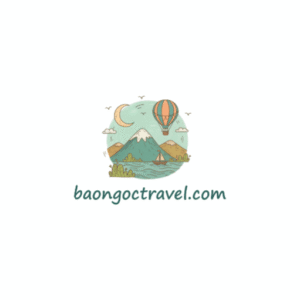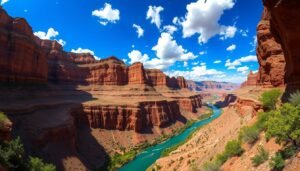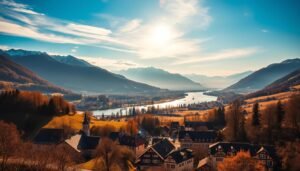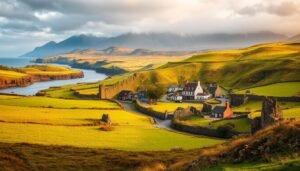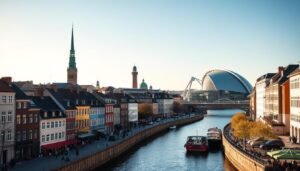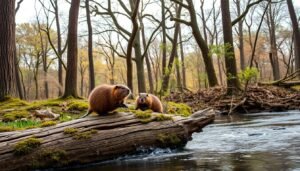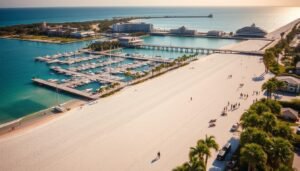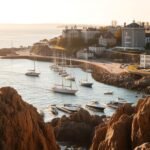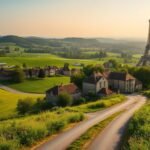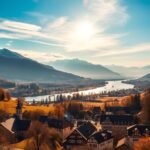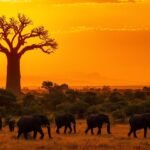Fact: I crossed five national parks through the Canadian Rockies on one trip, a stretch that spans an area larger than several countries and helped me see why this country ranks as the second-largest on the planet.
I planned a route that mixed big-name sights with quiet corners. I chased iconic views like lake louise at sunrise, walked Vancouver’s seawall, and rode the Maid of the Mist at Niagara Falls.
My trip balanced mountain days with lively city time. I paused for markets and small restaurants, then drove to coastal loops on Cape Breton Island and old streets in Quebec City.
What I learned: grouping sites by region kept travel efficient, and focusing on British Columbia early added variety—Vancouver Island’s rainforests and surf contrasted nicely with alpine lakes and national parks.
Key Takeaways
- I mixed famous landmarks and hidden gems for a full snapshot of the destination.
- Grouping stops by region saved time and let me savor each area.
- British Columbia offered big variety, from city life to wild coasts.
- Short, well-planned days let me hit major views without feeling rushed.
- Cultural sites and natural wonders together gave a richer travel story.
How I Planned My Trip to the Best Places to Visit in Canada
My planning began with a simple rule: cover less ground but soak up more of each region. I aimed for summer and the shoulder months so I could enjoy long light and milder weather.
When I went, I chose June and September whenever possible. These months had fewer visitors and more reliable mountain weather than the crowded July and August weeks.
“Focus on a region, not the whole map; you’ll see more and stress less.”
- I treated one province or a tight cluster as the core area so I swapped long drive marathons for relaxed exploration.
- I left a few flexible days for weather in the mountains and booked must-do things like gondolas and whale trips in advance.
- I grouped nearby parks and attractions, planned sunrise and sunset stops first, and picked one hero activity on heavy drive days.
- In any city, I stayed near transit and only rented a car when heading toward coast or peaks.
Outcome: This way of planning kept the trip efficient, reusable year-round, and full of memorable moments without the rush.things-to-do-in-long-beach
The Canadian Rockies: My Big-Mountain Base for World-Class Views
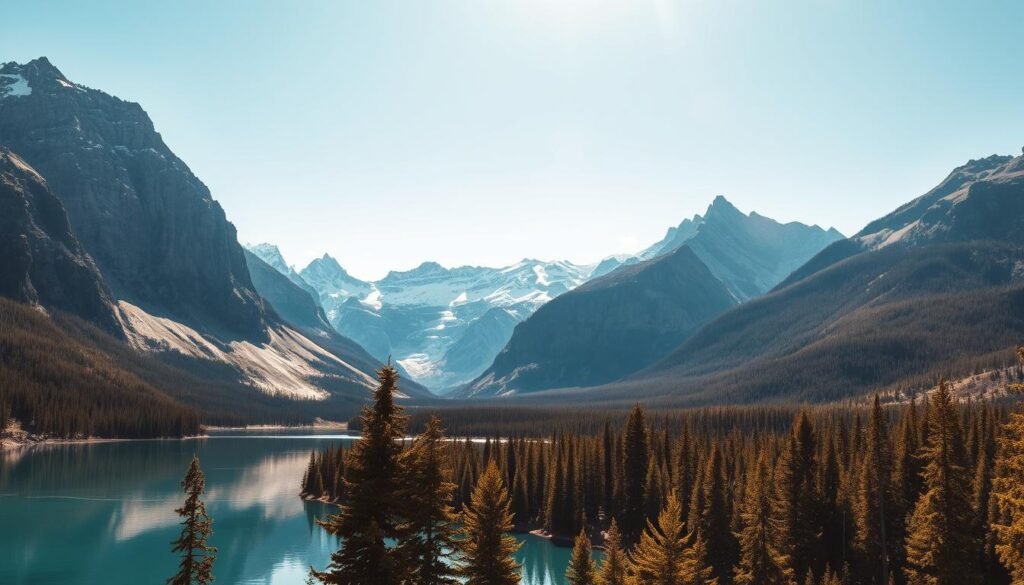
I used a single mountain base so I could hop between glaciers, lakes, and easy trailheads without wasting hours on the road. Staying central let me compare five nearby national parks in a single sweep.
Banff, Jasper, Yoho, Kootenay, and Glacier at a glance
The parks each had a clear personality: Banff’s headline lakes, Jasper’s vast wilderness, Yoho’s waterfalls, Kootenay’s hot springs, and Glacier’s rugged passes. Forests framed almost every trail and gave the region a quiet, scented calm.
Driving the Icefields Parkway for jaw-dropping scenery
The Icefields Parkway linked Banff and Jasper with nonstop views. I learned to slow my pace, pull over often, and let the scene settle.best-places-to-visit-in-alaska
“Every overlook felt like a postcard I hadn’t seen before.”
My favorite mountain towns: Canmore and Golden
I split nights between cozy Canmore and Golden to keep drives short and flexible. I even rode the Rocky Mountaineer for a glass-domed, panoramic ride that felt like a moving theater of beauty.
For a planning primer, I checked a Rockies bucket-list guide and timing notes: Rockies highlights and a short primer on seasonal timing in Banff here.
Banff National Park: Alpine Lakes, Trails, and Cozy Mountain Vibes
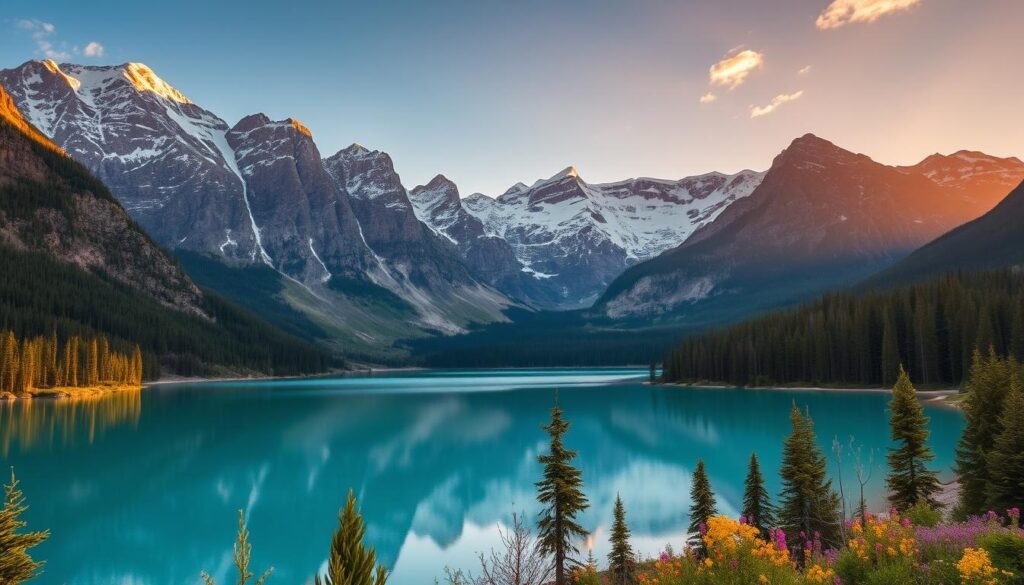
I spent bright mornings on glassy water and closed days with steam rising from a hot pool. The park, established in 1885 about 80 miles west of Calgary, felt both grand and manageable.
I kayaked on lake louise at dawn when the surface mirrored the peaks. Early hikes at Johnston Canyon let me hear the falls before crowds arrived.
Best time and seasonal highlights
Banff is rewarding year-round: summer paddles, golden fall trails, snowy winter skiing at Sunshine Village, and clear spring days that tease longer hikes.best-places-to-visit-for-christmas
Quick activity loop: lake, gondola, soak
I timed the Banff Gondola for late afternoon light so the views went pink. After the ride I walked into town for dinner at local restaurants and a warm dessert.
Practical notes and one-day planning
The park’s layout makes it easy to stack a gondola trip, a canyon walk, and a soak into a single day without long transfers. I kept the Banff Visitor Centre (224 Banff Avenue, 403-762-1550) handy for conditions and shuttle tips.
“Follow the lakes at dawn and leave afternoons for town and a soak.”
| Activity | Season | Duration |
|---|---|---|
| Lake Louise kayaking | Summer/Shoulder | 2–3 hours |
| Johnston Canyon hike | Spring–Fall | 2–4 hours |
| Banff Gondola | Year-round | 1–2 hours |
| Banff Upper Hot Springs | Year-round (cozy in winter) | 1 hour+ |
As part of the canadian rockies, Banff blends famous sights with quieter valleys. That mix kept each trip fresh and easy to repeat.
Jasper National Park: Bigger, Wilder, and Perfectly Peaceful

Jasper opened up like a wide, quiet map where every turn felt less crowded and more grand. The park felt larger and more relaxed than nearby hubs, with long horizons and deep, spruce-scented forests.
Maligne Canyon, Spirit Island, Jasper SkyTram
I started my mornings at Maligne Canyon, walking over bridges and peering into carved rock corridors. Then I took the boat to Spirit Island on Maligne Lake — that classic image truly matched the scene.
The Jasper SkyTram gave me a sweeping view of the valley and helped me pick ridges and forests I wanted to hike later. For quick planning, note the Jasper Visitor Centre: 500 Connaught Drive, Jasper, +780-852-6176.
Sulphur Skyline to Miette Hot Springs: my favorite hike-and-soak combo
The Sulphur Skyline trail is about five miles and climbs to a tough, rewarding ridge. After the summit, Miette Hot Springs was the perfect reward — warm pools and cool mountain air.
- Short drives linked my sunrise stops, canyon shadows, and an afternoon tram ride into one easy arc.
- I found cafés and trail snacks in town, then slipped back into quiet side roads for wildlife and empty trailheads.
- With its place in the canadian rockies, Jasper felt like a wilder corner of the country where I lingered longer than planned.
“Earn the summit, then melt into the pools with mountain air on your face.”
Vancouver: West Coast City Energy Meets Mountains, Forests, and Sea
![]()
I found Vancouver effortless: mountains, ocean, and a lively downtown all within easy reach. I biked the Stanley Park seawall and felt the forest on one side and blue water on the other.best-places-to-visit-in-montana
Stanley Park seawall, Gastown’s charm, and Granville Island food
I wandered Gastown’s cobblestone corner and watched the Steam Clock mark slow moments. Granville Island Public Market kept my energy up with local food finds and hands-on vendors.
Grouse Mountain views and Kitsilano Beach downtime
I rode the gondola up Grouse in late afternoon for sweeping views of the harbor, then coasted back to Kitsilano for a calm beach sunset. The Tourism Vancouver Visitor Centre (200 Burrard Street, Suite 210) was a handy stop for trail and transit notes.
- Walkable neighborhoods made many things easy without a car.
- I sampled small restaurants from sushi bars to farm-focused menus on the west side.
- Vancouver was a great home base for a short ferry hop around the province.
“Spending a day on the seawall, a market, and a skyline lookout put the highlights within reach.”
Vancouver Island: Wild Coasts, Rainforests, and Whale-Filled Waters

Stepping off the ferry, I felt the air change—salt, cedar, and a slower pace. Victoria became my gentle landing, where the Fairmont Empress afternoon tea felt like a pause between harbor views and street performances.
Victoria’s historic core and Empress tea
I wandered the Inner Harbour, then slipped into the Empress for tea and quiet people-watching. The city balance here made it easy to move from formal charm to casual waterfront walks.
Tofino surf, Pacific Rim drives, and Cathedral Grove giants
Driving the Pacific Rim Highway, I chased surf breaks and driftwood beaches near Tofino. Cathedral Grove humbled me—cedar and fir so old they felt like history you could touch.
Hot Springs Cove and Salt Spring’s markets
I booked a boat to Hot Springs Cove and sank into warm pools after a scenic ride. On Salt Spring, local markets fed my curiosity and my appetite with handcrafted food and friendly vendors in the town square.
“Peak summer gave the clearest light, but spring and fall offered moody coasts and quieter trails.”
- Vancouver Island felt like a world apart, with changing coast moods and green silence on trails.
- I kept binoculars handy—this place is home to orcas and humpbacks, and you never know when a whale might surface.
- For a compact trip, the island offered beaches, small-town charm, and rainforest hikes all within reach.
Johnstone Strait: Orcas, Kayaks, and Quiet Coastal Towns
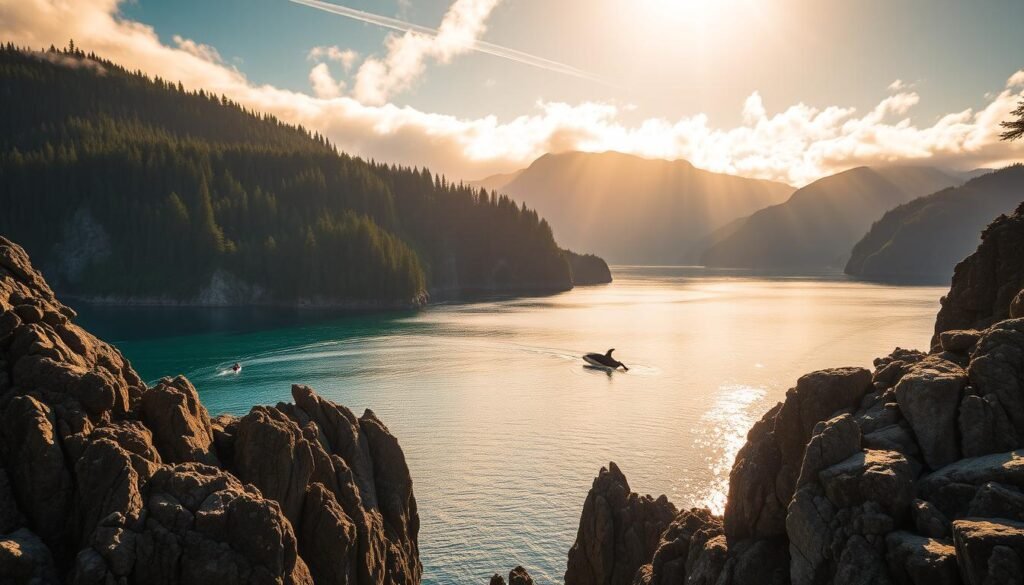
A narrow channel of glassy water and soaring firs set the tone for my days on Johnstone Strait. I based myself in Telegraph Cove, a tiny boardwalk town that makes early launches easy and keeps the pace slow.
Telegraph Cove base and Robson Bight Ecological Reserve
I used Telegraph Cove as my launch point for guided boat tours and solo paddles. Robson Bight Ecological Reserve sits nearby and offers thrilling views while boats keep respectful distance for the animals.
Best time for whale watching and calm-water paddles
July through September brought the highest chance of spotting an orca. The strait’s sheltered coast gave me calm-water paddles and frequent wildlife sightings, from dorsal fins to playful sea otters.
- I planned trips around tides and weather windows for safer, smoother paddling.
- Though it’s far from any big city, the setting felt remote yet welcoming.
- Locals and guides shared tips for respectful viewing and where visitors warm up after a morning on the water.
“Nature leads here; you show up with patience and a good thermos.”
Whistler: Big-Mountain Adventure Beyond Winter
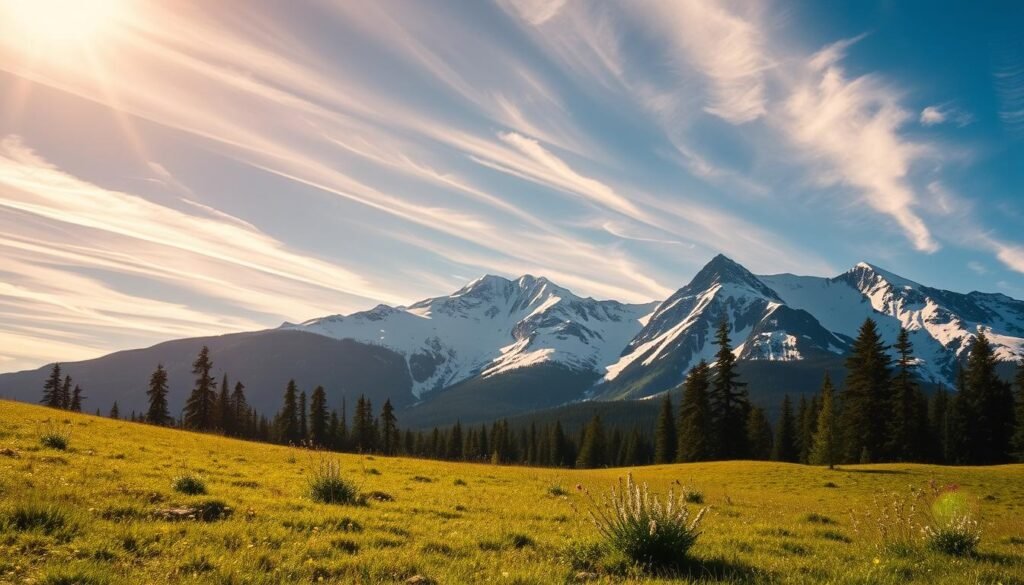
The Peak 2 Peak Gondola was my first hint that this mountain destination shines beyond the ski season.best-places-to-visit-in-october-usa
I learned quickly that Whistler, about 75 miles north of Vancouver and a 2010 Olympic co-host, hums with summer energy. Long daylight made a single day feel like three. From the gondola I soaked in wide alpine views and felt how alpine terrain sits right beside village life.
After a full trail or a biking lap on the side of the Coast Mountains, I reset at Scandinave Spa. Quiet pools and steam eased tired legs and extended the calm before dinner.
Whistler Village surprised me with lively cafés and smart restaurants. I chose one big activity each day—gondola, zip-line, or a guided bike ride—then filled spare hours with short walks and people-watching.
“Pair a lift-access viewpoint with a slow village stroll and you’ll get the mountain spirit fast.”
- Trails start near town, so transit time stays small.
- Summer festivals and markets add a local pulse.
- For first-timers, a single lift ride gives quick orientation and inspiration.
Niagara Falls: Iconic Power on the US-Canada Border

The falls hit my senses first — sound, spray, and a sudden sense of scale. Niagara Falls sits on the Niagara River between Ontario and New York, formed about 12,000 years ago. It comprises Horseshoe Falls (188 ft), American Falls (up to 110 ft), and Bridal Veil Falls (70 ft).
I gave myself two days here. I rode Maid of the Mist and got soaked — that wet rush is one of my one best big thrills in North America. I walked the tunnels at Journey Behind the Falls for a lower-point view, then booked Skylon Tower’s revolving dining room for skyline views.
Summer brought warm spray and rainbows, and even with many visitors, the scene never lost its quiet power. From Skylon’s observation point I traced the river and timed shots for evening lights.
“Even after a thousand photos, standing there reboots your sense of scale.”
| Activity | Season | Duration |
|---|---|---|
| Maid of the Mist boat | Mid-May–Mid-Sept | 30–60 minutes |
| Journey Behind the Falls | Year-round | 1 hour |
| Skylon Tower observation & dining | Year-round (best summer light) | 1–2 hours |
- I paired the boat with the behind-the-water tunnels for top-and-bottom perspective.
- Quick rim walks offered new angles as light and mist changed.
- This place proves why the falls rank as a world-class natural point of wonder.
Toronto: Skyline Thrills, Culture, and Neighborhood Food Finds
![]()
My first morning in Toronto began at the CN Tower and unfolded into cafés, markets, and ferry horns. The city sits on Lake Ontario’s northwest shore and felt lively without being frantic.
Start high, then slow down. I climbed the CN Tower for a skyline reset and used that wide view to map an easy downtown loop. After the tower, the Distillery District’s brick lanes offered galleries, cafés, and a quieter evening vibe.
Markets, islands, and midday plans
St. Lawrence Market made a tasty lunch stop and a quick source of local food finds. From there I hopped a ferry for a breezy day on the Toronto Islands and some waterfront walking.
Neighborhood grazing: Chinatown and Kensington
Chinatown and Kensington Market became my favorite areas to graze. Hand-pulled noodles, a vintage shop, and a bakery lined a single wandering hour. I treated the evenings as open slots for new restaurants and shows.
“Pair a morning skyline with an island afternoon and a Distillery dinner for a perfect short-city arc.”
| Spot | Best time | Typical duration |
|---|---|---|
| CN Tower observation | Late spring–early fall | 1–2 hours |
| St. Lawrence Market lunch | Year-round (busiest weekends) | 1 hour |
| Toronto Islands ferry & walk | Late spring–early fall | 2–4 hours |
| Distillery District evening | All seasons (festivals in summer) | 1–3 hours |
Practical note: Toronto’s transit makes hopping between things straightforward, so I skipped renting a car and enjoyed two relaxed days of wandering. The city felt like a cultural capital of the country, with festivals and museums packed into a compact core.
Quebec City: Old-World Romance and UNESCO Streets
Quebec City felt like a living postcard the moment I stepped into its narrow lanes. Founded in 1608, the town anchors the UNESCO World Heritage designation for Old Quebec, where cobblestones and turrets shape every turn.
I spent a few days letting the old quarter unfold slowly—stone lanes, café patios, and the Fairmont Château Frontenac towering above the river. Museums, boutiques, and bistros clustered close together, so I filled long afternoons without a car.
Château Frontenac, Old Quebec, and Montmorency Falls bridge walk
The château is a constant skyline point; its turrets made me plan photos at dawn and dusk. I crossed the suspension bridge at Parc de la Chute-Montmorency for a thrilling viewpoint over the cascade — that dramatic point balanced the town’s calm.
“I joined visitors from around the world to watch sunset wash the ramparts.”
- The heritage site streets feel like a step back in time, with street music in small squares.
- As the provincial capital, the city layers deep history with lively culture and local treats.
- From river outlooks to hidden alleys, every corner offered a new place to linger and discover.
I followed a simple rule: set out for one landmark and let myself get happily lost among many. For a short primer, see this Old Quebec guide for practical notes and walking routes.
Old Montreal: Cobblestones, Basilicas, and Waterfront Strolls
Old Montreal felt like stepping into a sepia photograph, but with espresso shops and street musicians at every corner.
I dedicated a couple of days to wandering the cobbled lanes, touring the Notre-Dame Basilica, and looping the Old Port at a relaxed pace.
The city shows a clear European flair in its façades and in the food—bagels, poutine, and market bites kept me fueled for long walks.
Bota Bota Spa on the river was my reset: a thermal circuit with skyline glimpses that felt special even in winter when the pools steamed into cold air.
“I balanced big sights with quiet backstreets, popping into galleries and small museums between espresso stops.”
- I used Mount Royal for a classic overlook, then slipped back into the old quarter for a golden-hour photo walk.
- The neighborhood is best explored on foot; there are endless small details—iron balconies, musicians, and cobbles underfoot.
- Evenings along the waterfront closed the day perfectly, with lights across the river and easy riverside strolls.
| Highlight | When to go | Typical time |
|---|---|---|
| Notre-Dame Basilica tour | April–May, Sep–Nov | 1–1.5 hours |
| Old Port walk & market | Spring–Fall | 2–3 hours |
| Bota Bota Spa thermal circuit | Year-round (noted for winter) | 2–3 hours |
Nova Scotia Road Trip: Cape Breton Island, Colorful Ports, and Coastal Parks
A coastal loop from Halifax became my map for slow mornings, bold cliffs, and small-town pauses.
I started in the capital, then traced shorelines where the province shows off more than 13,000 km of coast and the shared claim to the world’s highest tides.
Halifax, Peggy’s Cove, Lunenburg, and UNESCO charm
I wandered Peggy’s Cove for lighthouses and hopped into Lunenburg’s colorful lanes—an official world heritage site with classic façades that felt like a living postcard.
Cabot Trail drives, whale watching, and Kejimkujik
Cape Breton’s Cabot Trail gave repeated ocean overlooks over a couple of days, while Kejimkujik National Park offered forests and calm lakes for a quieter break.
Whale-watching days were my flexible wildcards—when seas looked right, I rearranged the route and booked a tour.
When to go: summer light, fall color, and seafood season
I timed one trip for long summer drives and warm breezes, then came back in fall for foliage and seafood season when the coast felt cozier and the small towns welcomed me like home.
“This trip was built for wandering—an island detour or a side road often led to the week’s best photo.”
- I planned coastal loops from Halifax and kept options open for island side trips.
- Local chowder on wharves and friendly tips from fishers made the route feel personal.
- Between lighthouses and parks, culture, coastline, and fresh seafood fit together easily.
Beyond the Beaten Path: Yoho’s Emerald Lakes and Canada’s Far North
A short detour into Yoho and a longer swing north showed me two very different kinds of wild.
Yoho National Park in British Columbia felt like a painter’s palette. Emerald Lake’s color was unreal, Takakkaw Falls thundered before I reached the viewpoint, and Lake O’Hara’s alpine loops rewarded careful planning.
Yoho is part of the Canadian Rocky Mountain Parks UNESCO World Heritage landscape and even holds Burgess Shale fossils that hint at deep time.
Yoho highlights
- Emerald Lake: bright color and calm shoreline walks.
- Takakkaw Falls: an immediate, roaring point of scale.
- Lake O’Hara: reserve access but unforgettable alpine circuits.
“The park felt compact yet connected to its neighbors—day trips stacked easily without heavy backtracking.”
North: Yukon and Northwest Territories
Driving the Dempster Highway, I felt gravel under tires and long summer light. Whitehorse and Dawson City offered history and small‑city charm, while Tombstone and Kluane showed serrated peaks and endless tundra.
I chased the midnight sun and learned that this northern route demands patience, respect, and flexibility.
| Region | Highlight | Season |
|---|---|---|
| Yoho (province: British Columbia) | Emerald Lake, Takakkaw Falls, Lake O’Hara | Spring–Fall |
| Yukon | Whitehorse, Dawson City, Kluane | Summer (midnight sun) |
| Northwest Territories | Dempster route, Yellowknife aurora access | Summer & Winter (aurora season) |
For timing and practical notes, see a short Yoho planning guide that helped me schedule Lake O’Hara access and trail options.
Conclusion
When I look back, the trip’s greatest asset was how the regions threaded together. From Vancouver’s seawall and Niagara’s Skylon Tower to Old Quebec’s UNESCO lanes and Cape Breton Island, the route mixed city energy with coastlines and high peaks.
I left buffer days in the plan so weather and whim could steer me. That gave me extra sunsets, unplanned detours, and time where a single place held my attention longer than expected.
If you plan a similar route, anchor your map with a few big draws, then link them with short, scenic hops. Give each stop room to breathe, and let flexibility turn good moments into lasting memories.



